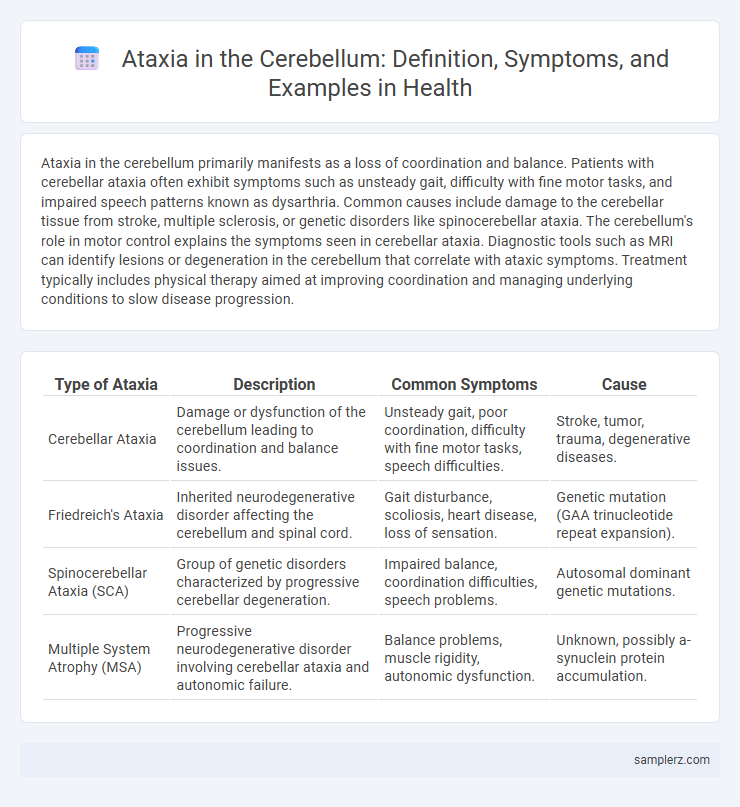Ataxia in the cerebellum primarily manifests as a loss of coordination and balance. Patients with cerebellar ataxia often exhibit symptoms such as unsteady gait, difficulty with fine motor tasks, and impaired speech patterns known as dysarthria. Common causes include damage to the cerebellar tissue from stroke, multiple sclerosis, or genetic disorders like spinocerebellar ataxia. The cerebellum's role in motor control explains the symptoms seen in cerebellar ataxia. Diagnostic tools such as MRI can identify lesions or degeneration in the cerebellum that correlate with ataxic symptoms. Treatment typically includes physical therapy aimed at improving coordination and managing underlying conditions to slow disease progression.
Table of Comparison
| Type of Ataxia | Description | Common Symptoms | Cause |
|---|---|---|---|
| Cerebellar Ataxia | Damage or dysfunction of the cerebellum leading to coordination and balance issues. | Unsteady gait, poor coordination, difficulty with fine motor tasks, speech difficulties. | Stroke, tumor, trauma, degenerative diseases. |
| Friedreich's Ataxia | Inherited neurodegenerative disorder affecting the cerebellum and spinal cord. | Gait disturbance, scoliosis, heart disease, loss of sensation. | Genetic mutation (GAA trinucleotide repeat expansion). |
| Spinocerebellar Ataxia (SCA) | Group of genetic disorders characterized by progressive cerebellar degeneration. | Impaired balance, coordination difficulties, speech problems. | Autosomal dominant genetic mutations. |
| Multiple System Atrophy (MSA) | Progressive neurodegenerative disorder involving cerebellar ataxia and autonomic failure. | Balance problems, muscle rigidity, autonomic dysfunction. | Unknown, possibly a-synuclein protein accumulation. |
Overview of Ataxia in Cerebellar Disorders
Ataxia in cerebellar disorders manifests as impaired coordination and balance due to dysfunction in the cerebellum's role in motor control. Common examples include spinocerebellar ataxia and cerebellar stroke, which lead to symptoms such as unsteady gait, dysmetria, and intention tremor. Early diagnosis through neurological examination and imaging is crucial for managing disease progression and improving patient outcomes.
Common Types of Cerebellar Ataxia
Common types of cerebellar ataxia include spinocerebellar ataxia (SCA), Friedreich's ataxia, and episodic ataxia. Spinocerebellar ataxia encompasses a group of hereditary disorders characterized by progressive degeneration of the cerebellum and its connections, leading to gait instability, poor coordination, and speech difficulties. Friedreich's ataxia involves mitochondrial dysfunction and predominantly affects the spinal cord and peripheral nerves, causing muscle weakness, sensory loss, and cardiomyopathy alongside cerebellar symptoms.
Clinical Manifestations of Cerebellar Ataxia
Cerebellar ataxia manifests through symptoms such as uncoordinated gait, dysmetria, and intention tremor, reflecting impaired motor control. Patients often exhibit dysarthria, nystagmus, and hypotonia due to cerebellar dysfunction. These clinical signs result from disrupted cerebellar pathways essential for balance, posture, and fine motor coordination.
Gait Disturbances as Examples of Cerebellar Ataxia
Gait disturbances in cerebellar ataxia typically manifest as an unsteady, wide-based walk with irregular steps and poor coordination, reflecting dysfunction in the cerebellum's role in motor control. Patients often exhibit difficulty maintaining balance, frequent staggering, and an inability to perform heel-to-toe walking, which are hallmark signs of cerebellar impairment. These symptoms result from disrupted neural pathways affecting proprioception and muscle coordination essential for smooth, controlled movements.
Limb Incoordination in Cerebellar Dysfunction
Limb incoordination in cerebellar dysfunction often presents as ataxia, characterized by unsteady, clumsy movements and difficulty with precise motor tasks such as finger-to-nose or heel-to-shin tests. This condition results from impaired cerebellar processing affecting motor planning and execution, leading to dysmetria and intention tremor. Patients exhibit a distinctive gait disturbance and poor hand-eye coordination, which are hallmark signs in disorders involving the cerebellum.
Speech Impairments Linked to Cerebellar Ataxia
Cerebellar ataxia often manifests as dysarthria, characterized by slurred or slow speech due to impaired motor control of the speech muscles. Patients may experience irregular speech rhythm, poor articulation, and difficulty coordinating breathing with phonation, reflecting cerebellar dysfunction. These speech impairments significantly impact communication and are critical for diagnosing cerebellar ataxia.
Oculomotor Abnormalities in Cerebellar Pathology
Oculomotor abnormalities in cerebellar pathology, such as gaze-evoked nystagmus and saccadic dysmetria, are hallmark signs of ataxia associated with cerebellar damage. These eye movement disturbances reflect impaired coordination and timing due to cerebellar dysfunction, often observed in conditions like spinocerebellar ataxia and cerebellar stroke. Precise evaluation of these abnormalities aids in the diagnosis and differentiation of cerebellar ataxias from other neurological disorders.
Causes and Risk Factors for Cerebellar Ataxia
Cerebellar ataxia arises from dysfunction or damage to the cerebellum, with common causes including genetic mutations, stroke, multiple sclerosis, and chronic alcohol abuse. Risk factors encompass family history of hereditary ataxias, exposure to neurotoxins, autoimmune disorders such as gluten ataxia, and vitamin deficiencies like vitamin E or B12. Early identification of these causes and risk factors is essential for targeted management and improving patient outcomes.
Diagnostic Approaches for Cerebellar Ataxia
Cerebellar ataxia, often linked to disorders such as spinocerebellar ataxia and multiple system atrophy, requires precise diagnostic approaches including MRI to detect cerebellar atrophy and electrophysiological studies to evaluate nerve function. Genetic testing plays a critical role in identifying hereditary forms of cerebellar ataxia, while cerebrospinal fluid analysis helps exclude inflammatory or infectious causes. Comprehensive neurological examinations combined with neuroimaging and molecular diagnostics enhance the accuracy of cerebellar ataxia diagnosis, guiding appropriate treatment strategies.
Management and Rehabilitation Strategies for Cerebellar Ataxia
Management of cerebellar ataxia involves a multidisciplinary approach including physical therapy to improve coordination and balance through targeted exercises. Rehabilitation strategies emphasize gait training, proprioceptive exercises, and the use of assistive devices to enhance mobility and reduce fall risk. Pharmacological interventions and occupational therapy are also integrated to address underlying causes and support daily functioning.

example of ataxia in cerebellum Infographic
 samplerz.com
samplerz.com